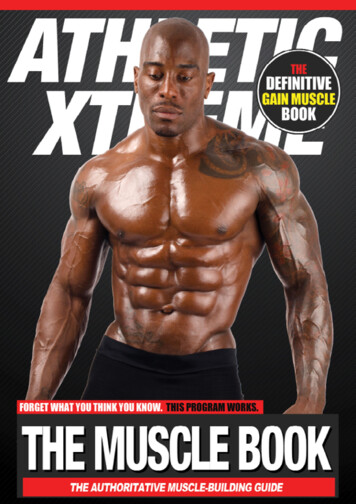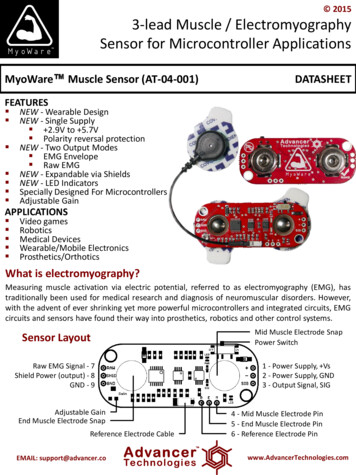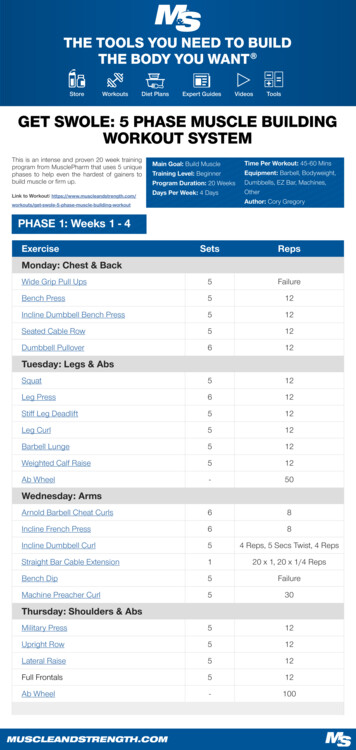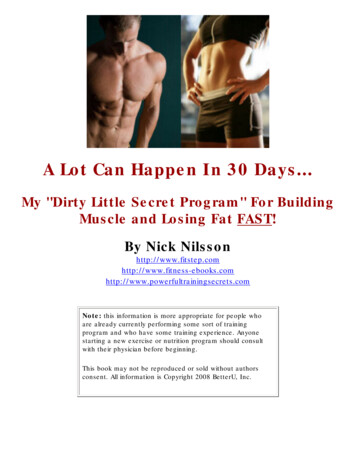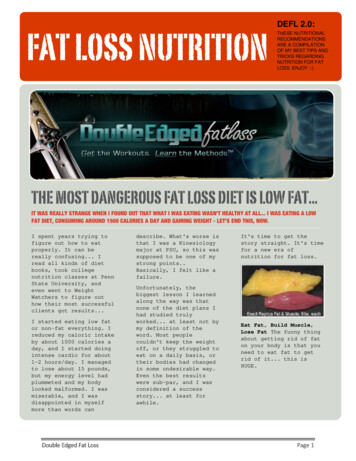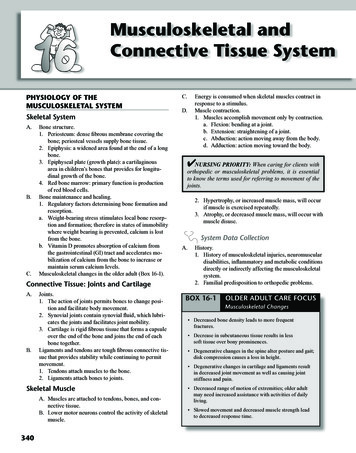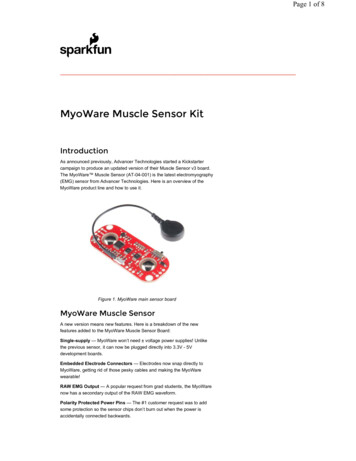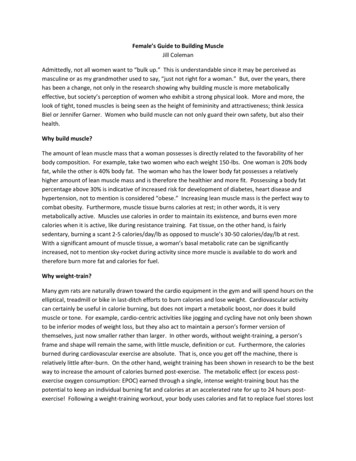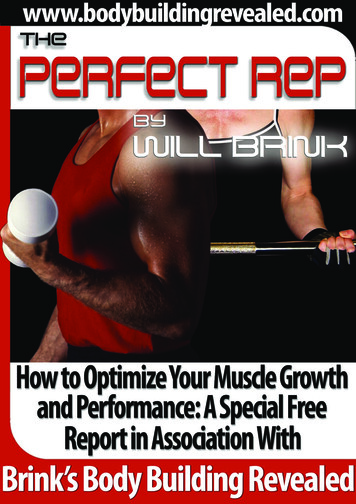
Transcription
ThePerfect RepThePerfect repByWill Brink, creator of:Brink’s BoDy BuilDingReveaLeDIknow what you’re thinking, “I hope this is not going to be another redundant trainingreport!” Having written articles on virtually every facet of bodybuilding at one time oranother, I am the first to admit that training articles can get redundant. OK, maybe even flatout boring.Nutrition is an endless subject, and most bodybuilders can read articles on nutrition endlessly,but training articles can bore the pants off of people. Why? Because most are either full ofjargon lacking any real life application, or fail to say anything new or even believable. I thinkpeople tend to glaze over in a sort of semi stupor when reading certain training articles, likewatching the “700 Club” on a Sunday morning. Well friends, I think you will find this trainingreport low in jargon, high in utility, and not too painfully boring to read (I hope).This training report is on a very simple topic: the rep itself and style of rep I have found to beproductive to growth. Now before you go turning the page, consider just how important thesimple rep is to your success.If you think about it, the rep is not only the most basic concept in all of weight training, butalso the most fundamental aspect for growth. There are stacks of theories on what is the bestroutine, volumes of research on how muscles grow and what is the most effective number ofreps for muscle growth, and countless ways to increase intensity to stimulate the muscles.In the end however, it comes down to the rep itself. If your reps are done incorrectly, whatdoes it matter which routine you are using? An incorrectly executed rep undermines whateverexercise you choose; theory you adhere to, or guru you follow in your quest for new muscle.If a person only gets a few “good” reps per set, and the rest are a waste of time, could this person dramatically improve the efficiency and effectiveness of their workouts by making everyrep a “good” rep? I think you know the answer to that question, so I will not answer it. If youdon’t know the answer to that question, then brother, you are in the wrong sport and a golfclub might be better suited for your hands than a dumbbell!Copyright Will Brink And Internet Publications. You are welcome to pass on this special report to others. You maynot however, edit it, extract content from it or offer it for sale in any way2
ThePerfect RepAspiring bodybuilders often get caught up inthe latest theories on weight training yet failto grasp the importance of the foundation ofgrowth itself: the simple rep.Talking about how to perform a rep is notsexy, high tech, or something that can be putin a bottle and sold as a supplement (RepRX?),yet in the final analysis, the rep is what standsbetween you and more muscle and is the veryplace so many bodybuilders fall short.They slop through their reps, rush through their reps, or have no intensity during their reps,but rarely see what is under their nose: It isn’t the routine they’re following, the supplementsthey’re taking, or the diet they eat that stops their muscle growth, but the very way they perform their reps that keeps them from getting larger. Translated: Sometimes it’s not what youdo, but how you do it!People tend to look for complex answers to simple problems. I get stacks of letters and e-mailfrom people with all sorts of questions as to why they are not making any progress. Their theories range from “I think it was the descending set-negative feedback loop-burn sets that stopmy muscle growth”, to “Aliens have put growth retarding chemicals in my creatine.”With that introduction, let us get onto what is the ultimate growth rep, with a little scientificmumbo-jumbo in between.What actually causes muscle growth?This is the point in the article where I could go into a long and unusually boring dissertationabout muscle physiology: Muscle fiber types, controversies over whether the muscle getslarger or divides into new muscle cells, or both.Number of reps, volume of training, concentric, eccentric, isometric, etc.: this is importantinformation for the research scientist, but not all that relevant to the hard training bodybuilder.I mean, what are we looking for here? In a nut shell, what we want is the correct level ofstimulation to a muscle to make it larger, right? Too little stimulus and the muscle won’t grow.Too much stimulus and the muscle doesn’t grow, or worse yet, gets smaller due to injury orinability to recuperate. The proper stimulus within a given period of time is what we are looking for.This brings me to another point. It is not the amount of actual weight that is the most important factor to muscle growth, but the actual amount of stress or tension the muscle must endure during the rep that is the crucial stimulus for growth. But some might ask “Doesn’t usingmore weight mean more stress on the muscle?”Copyright Will Brink And Internet Publications. You are welcome to pass on this special report to others. You maynot however, edit it, extract content from it or offer it for sale in any way3
ThePerfect RepThe answer is no.If you take 405 lbs. off the rack when bench pressing and bring it down quickly without control, bounce it off your chest and lock the elbows out hard at the top for one rep, are youcreating more stimulus to the pec muscles than if you took 300 lbs. off the rack and brought itdown with full control, pressed it up without any bounce or momentum, and did not lock theelbows out at the top for ten reps?I think the answer to that question is obvious, and we will examine this particular topic in thecoming sections.The point I am trying to make here is that weight is only a factor within the variable of howthe rep itself is performed. All things being equal (i.e., each rep is performed correctly for thatexercise) weight does matter.The more weight you can use in a given exercise, with correct form, in a given time period, fora specified number of reps, the more stimulus for growth the muscle will experience. However, using more weight for the sheer sake of using more weight, not taking into account howthe rep is performed, does NOT equal more stress on the muscle.When we talk about a stimulus for growth, we must look beyond the simple micro-environment of the muscle fiber in question. This is where bodybuilders and scientists often fall shortwhen trying to examine the topic of muscle growth. An examination at the level of the musclefiber, where the actual damage occurs, is obviously important for any study of why and howmuscles grow from weight training.However, it is not the only factor involved leading to the increase in size and/or number ofmuscle fibers in response to weight training.When we train with weights using sufficient loads and intensity, we cause micro-trauma tothe muscle fiber(s). That is, at the level of the fiber itself, we have caused a certain amount ofcontrolled damage to the fibers involved.However, muscle growth is far more involved than simple breakdown and repair. This is thepoint in the report where we need to look at the concept known as the “metabolic cost of exercise.” This concept, though complex if you map it all out, can still be reduced to its most basic definition: Muscle growth is not a local event that happens exclusively at the level of themuscle fiber, but is ultimately a systemic response to exercise that leads to muscle growth.So what exactly is meant by “systemic?”It means that when we lift a weight several things happen. At the level of the muscle, thereis controlled damage to the myofiber during muscular contraction. This damage (known asmicro-trauma) leads to remodeling (growth) of the muscle predominantly takes place duringthe eccentric (negative) part of the rep.Copyright Will Brink And Internet Publications. You are welcome to pass on this special report to others. You maynot however, edit it, extract content from it or offer it for sale in any way4
ThePerfect RepSimply put, at the local level of the muscle fiber, it is the lowering(negative) part of the exercise that is responsible for most of thedamage to the fiber that (hopefully) leads to muscle hypertrophyand increases in strength.From this information we can conclude that a controlled rep,where the weight is lowered under full control, is a particularlyimportant part of a properly executed rep.Now this is what is happening at the local level of the muscle fiber, but as I said before, muscle growth is ultimately controlled bythe effects exercise has on the entire system. For example, as anybodybuilder knows, growth hormone is one of several anabolichormones important for increasing muscle mass and sheddingbody fat.Growth hormone is a key anabolic and lipolytic (fat mobilizing) hormone that many bodybuilders are injecting pre-contest and off season to build additional mass and burn fat. However, growth hormone (GH), insulin, human growth factor one (IGF-1), and to a lesser degreetestosterone, can be partially manipulated by diet and exercise, so don’t think an elephantpituitary extract enema is the only way you will ever add new muscle!The metabolic costs of exercise can be shown in this example: When we lift weights we causea rise in lactic acid. Research suggests that the signal to release growth hormone in responseto exercise is related to the level of lactic acid in the blood. It is a system-wide response to theexercise (i.e. the increasing level of lactic acid in the blood) that causes growth hormone tobe released.In fact, the body produces many metabolites and metabolic byproducts in response to weightlifting that contribute to the growth of lean tissues being trained.What does this tell us?It tells us that weight training does not just cause controlled damage to muscle fibers to stimulate growth but has a systemic effect. It suggests weight training has a high metabolic costthat stimulates the entire body to respond to the exercise in a positive way.Another example of a systemic response to weight training is not commonly appreciated.When a person first starts to train with weights, their strength climbs rather quickly, yet theyput on relatively little muscle. What is going on here? Scientists have postulated that this earlyrise in strength in response to weight lifting takes place from an improved efficiency of thenervous system, that it is a neural adaptive response.Personally, I believe that the efficiency of the nervous system continues to play an importantrole in the process of building muscle even after many years of training, but that’s anotherstory.Copyright Will Brink And Internet Publications. You are welcome to pass on this special report to others. You maynot however, edit it, extract content from it or offer it for sale in any way5
ThePerfect RepYou see, this is an example that demonstrates it is not only what happens to the musclesthemselves when we train, but what happens to our entire system when we train. The nervoussystem becomes more efficient, the endocrine system responds, and various enzymatic pathways are affected. The body’s response to weight training is clearly not a local event relegatedsimply to its direct effects on muscle fiber but is actively promoting a systemic response.These are a few examples of how the systemic response to exercise leads to increases in sizeand strength. The metabolic cost of exercise probably plays as crucial a role in muscle growthas does the local stimulation to the muscles (i.e. myofiber damage caused by intense musclecontraction).So how do I improve the quality of my reps?OK, I’ll bite. How do I incorporate the above knowledge into workout, you ask? Before we getto that, let’s quickly review what the previous section tells us.Different types of training can still elicit growth. It tells us that manipulating certain variablesin our training, such as intensity, volume, and other factors, is essential for growth. It is probably why some people can get stronger but not get much bigger and why power lifters andbodybuilders can look so much different from each other.Finally, and most importantly in my view, it tells us that along with lower reps, moderate tohigher reps have an important place in our training regimen as they have the highest metabolic demand - which may have an important systemic effect on our long term ability to increase lean tissue.So what style of rep causes adequate stimulus for growth (i.e. micro-trauma) and has a highmetabolic cost? Elementary my dear Watson: it would be the “continuous-tension non-lockout” (CTNL) rep.I told you it would not be all that sexy or high tech when I told you what it was - but how andwhy you should use it might be.Our goal of using continuous-tension non-lock out style reps is to keep, as the name implies,the most amount of tension (stress) possible on the muscle(s) being trained. Continuous-tension non-lockout (CTNL) reps are probably the most metabolically costly reps you can do;especially if they’re done for moderate to high reps.The systemic effect (i.e. the amount of exercise induced metabolites such as lactate) is generated more quickly and at higher levels than with any other style of training. The amount ofactual time the muscle is under tension is greatest when the reps are done in a CTNL fashion.As stated earlier, many people slop through, chop through, rush through their reps, totallylacking the intensity required during each set of an exercise.Are the muscles and the entire system being stimulated to a greater degree when you slopCopyright Will Brink And Internet Publications. You are welcome to pass on this special report to others. You maynot however, edit it, extract content from it or offer it for sale in any way6
ThePerfect Repthrough your reps in an attempt to use big weights? No.It is the amount of tension, and the length of time the muscle is under that tension, that is thekey. When CTNL reps are properly performed the muscle is under tension 100% of the time inevery rep of every set. It is one of the most grueling and effective ways you can train.Incorporating CTNL reps into a workoutSo how do we use this seemingly simple rep style in a workout? A properly done CTNL rephas a cadence or rhythm to it. A person who can do CTNL reps well will make the first rep lookalmost identical to the last rep. The entire set has a cadence to it. When doing the CTNL repyou should take about 3-4 seconds for the eccentric (negative) part of the movement and 2seconds for the concentric (positive) part of the movement.If you look at the typical set of the typical aspiring bodybuilder, you will usually notice thatthey start the set out by doing the reps one way and as the set progresses the reps get fasterand looser in form. This is the result of the brain going into self-preservation mode and wanting to finish the set as fast as possible.The real challenge of doing an entire set in the CTNL rep fashion is to keep the same pace orrhythm on the last rep as you began the set with. This is a lot easier said than done.As the lactic acid starts to build up, your mind starts to count the ways out of this revoltingsituation to speed the reps up or use some leverage to take the stress off the muscle.As the pH of the blood drops (from the rise in lactic acid), it becomes more and more difficultfor the nerves to fire. Being able to do the reps in the CTNL rep fashion dramatically improvesnervous system efficiency among other adaptations that take place.People who first begin using the CTNL rep style of training notice a big drop in the loads theycan use on an exercise. However, as time goes by, their nervous system, buffering systems, andenzymatic pathways come up to the challenge. Ina short time they are able to use the same weightthey could use before but are now being muchmore efficient in their workouts and are creatingfar more stress to the muscles than ever before.People who train this way find they need to dofewer sets per body part and are amazingly sore afew days after their workouts.Now let’s take a look at an exercise like the squatand how a typical set done in the CTNL rep fashion would be performed. CTNL reps are best donefor moderate to high reps because this causes thegreatest metabolic demand and generation ofCopyright Will Brink And Internet Publications. You are welcome to pass on this special report to others. You maynot however, edit it, extract content from it or offer it for sale in any way7
ThePerfect Repexercise induced metabolites (along with the damage at the level of the muscle fiber). Also,CTNL reps are most effective when done in full range of motion for that muscle.OK, back to the squat. After warming up you would pick a moderate weight, a weight youcould normally get around ten reps with. Descend into the rep, concentrating on keepingfull tension on the muscles of the legs, at the rate of 3-4 seconds. At the bottom of the squat,come back up strong but controlled at 2-3 seconds (obviously you will not be able to look ata stop-watch while doing this, but you get the idea). This is where we get to the non-lock outportion of the rep.When you approach the top of the rep, you do not come all the way up to an upright positionand stand up with weight. Why? It’s because this takes the tension off the muscles. You areresting! Instead, as you approach the top of the rep, in a controlled fashion, you then reversedirection and again descend back into the bottom the rep. For a fleeting second, you get closeto standing upright with the weight, but you never quite do it.Now this might seem amazingly simple, but as the reps continue, 5, 8, 10, 12 reps, you willreceive the inner directive to either speed up the tempo of the reps, stand up with the weightand rest, or just dump the weight on the floor!This is where you have to dig down deep and force yourself to not only complete the reps butmaintain the tempo you started with, never letting up the tension on the muscle. This is wherethings get tough, and the CTNL rep excels at making larger people out of smaller people!When you get good at it, you should be able to get 12-15 reps in this style.At first try, most people fail miserably at training like this. Their nervous system just conks outon them. Their lactic acid buffering systems are not yet up to the task, and the mind won’ttolerate it. However, as time goes by you will be amazed how strong you will get. Don’t lookfor monster poundages when training like this, at least not in the beginning.CTNL style reps are not best suited for increases in strength, though you can get quite strongat it, but they are highly effective for increasing muscle size.CTNL reps are a focused andmentally demanding way oftraining, but the results areworth it. Certain people reading this will give these ideas atry and will say to themselves“damn, how could somethingas simple as changing the wayI do my reps be right under mynose all this time?” While others might say “I know all thisstuff” and blow it off assumingCopyright Will Brink And Internet Publications. You are welcome to pass on this special report to others. You maynot however, edit it, extract content from it or offer it for sale in any way8
ThePerfect Repwhat I have said here is too basic to be of any use to them. Take it or leave it, you can’t avoidthe importance of the simple rep.Tips for success using CTNL repsAlways strive to use progressive resistance, that is, try to achieve a personal best when possible. Many people misinterpret the concept of progressive resistance to mean constantlyusing more weight.Obviously, you will not be able to add more weight to every workout indefinitely. Sometimes it is doing two sets of ten with a weight you could only do one set of ten with before.Sometimes it is doing eleven reps with a weight you could only get ten reps with the weekbefore, or it can even be doing two sets of 12 reps with a weight you did the week before,but knocking off a few minutes of rest between those two sets, thus causing more stress onthe muscle.Weight is important, but making it your one and only focus will ultimately lead you downthe road to disappointment. There are many ways to increase the stress on the muscle. Forinstance, what do you do at the end of the set, when you absolutely positively cannot doone more rep in the CTNL fashion? At this point you can rest and do one of a few options: You could just be done with the setYou could do a few forced repsYou could do a few negativesYou could do a few “cheat reps” depending on the exerciseFinally, you could reduce the weight and continue with the setMost of the time, you should really just be done with the set because they can be quiteintense. Throwing in one of the above intensity enhancing strategies once in a while is fine,but overtraining is a guarantee if you do it too often.1. For upper body, performing 8-12 reps in this fashion is optimal for causing adequatemicro-trauma to the muscle and creating the required metabolic cost. For lower bodyexercises, higher reps can be used. For example, after getting a few heavy sets of 8-10reps on say squats, a set of 15-20 reps in CTNL fashion is essential on leg day. Believe me:you haven’t lived until you have done a set of squats for 20 reps in this fashion with amaximum weight.2. CTNL reps work equally well with any exercise: dead lifts, leg extensions, military presses,you name it. I would recommend no more than 8-10 sets per body part on larger musclegroups (legs, back, chest) and no more than 6-8 sets for biceps, triceps, and delts, because this style of training can be very intense when done correctly and overtraining is adistinct possibility.Copyright Will Brink And Internet Publications. You are welcome to pass on this special report to others. You maynot however, edit it, extract content from it or offer it for sale in any way9
ThePerfect RepWill Brink:meet. Writer/Contributing Editor Monthly columnist for MuscleMag International R&D and Marketing Consultant to the health andfitness industry. Trainer of high-level athletes, police and militarypersonnel. Guest on syndicated radio programs Author of “Priming The Anabolic Environment”.“Fat Loss Revealed” andBrink’sBoDy BuilDinGReveaLEDAfter 4 years and sales in over 120 countries, ”Brink’sBody Building Revealed” has grown into the mostcomplete e-book on the market on the science ofbodybuilding nutrition, supplementation and training.BBR has over 400 information-packed pages on: Anabolic nutrition and dietBodybuilding supplement reviewsBodybuilding workoutsMotivation & goal-settingIn addition, there are special bonus reports written by written by none other than world-famousstrength coach Charles Poliquin, and Dr. Evan R. Peck, a specialist in sports injury prevention and rehabilitiation.But what really sets BBR apart from other bodybuilding programs is my massive, private, members-only online area. Only my customers have access to the wealth of additional information and tools found there. In the Members’ Area, you can:Copyright Will Brink And Internet Publications. You are welcome to pass on this special report to others. You maynot however, edit it, extract content from it or offer it for sale in any way10
ThePerfect Rep Speak to me directly - I’m on there every dayRead one of the 450 reviews on brand name supplementsPost a request for a supplement to be reviewedPost questions on Diet, Training or SupplementationWatch The Weekly Bodybuilding VideoRead The Daily Bodybuilding Tips & QuotesRead Exclusive Articles in Guru Articles SectionUse the BBR Meal Planner to create your mealsDownload Pre-made Bodybuilding Sample DietsUse the BBR Diet Planner, to record what you eatAdd Your Photos to the GalleryClick to Order A Copy Now!Watch Videos of all the exercises in my programUse the Food Database, with calorie, protein, carbs andfat info on over 50,000 foods.As you might have guessed from the photos and testimonials at Brink’s Body Building Revealed, buying BBR was one of the best decisions many of our members havemade in their lives.Hope to see you in the Members’ Area!Will BrinkP.S. For more information on me, what I do, and what I have to offer, check out mypersonal website, The Brinkzone. I’ve got a huge archive of some of my best articles,as well as a full resume. Please feel free to explore as much as you like, and leave acomment or two on my weblog!P.P.S. If you’re also interested in losing fat and seeingthose abs, check out my other book, “Fat Loss Revealed.”The FLR System is one of the best on the market today,for losing fat, and staying lean for life. It’s a comprehensive lifestyle program that provides you with the infoyou need on nutrition, diet, weight loss supplements,strength training, cardiovascular fitness, goal-setting,and more!Check out Will Brink’s Fat Loss Revealed today!E-Book Creation by Midas3.comCopyright Will Brink And Internet Publications. You are welcome to pass on this special report to others. You maynot however, edit it, extract content from it or offer it for sale in any way11
report!” Having written articles on virtually every facet of bodybuilding at one time or another, I am the first to admit that training articles can get redundant. OK, maybe even flat-out boring. Nutrition is an endless subject, and most bodybuilders can read articles on nutrition endlessly
